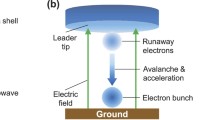Abstract
A case is made that in encounters with the earth's atmosphere, astrophysical little black holes (LBH) can manifest themselves as the core energy source of ball lightning (BL). Relating the LBH incidence rate on earth to BL occurrence has the potential of shedding light on the distribution of LBH in the universe, and their velocities relative to the earth. Most BL features can be explained by a testable LBH model. Analyses are presented to support this model. LBH produce complex and many-faceted interactions in air directly and via their exhaust, resulting in excitation, ionization, and light due to processes such as gravitational tidal force, bremsstrahlung, pair production and annihilation, orbital electron near-capture by interaction with a charged LBH. Gravitational tidal force interaction of LBH with polarization and atmospheric atoms can result in an enhanced cross-section for polarization and ionization. An estimate for the power radiated by BL ∼ Watts is in agreement with observation. An upper limit is found for the largest masses that can produce ionization and polarization excitation. It is shown that the effects of LBH high power exhaust radiation are consistent with observations.
Similar content being viewed by others
References
Argyres, P.C., Dimopoulos, S. and March-Russell, J.: 1998, Phys. Lett. B 441, 96.
Bach, E.W.: 1993, 'UFOs' from the Volcanoes, Hermitage Publishers, Tenafly, NJ.
Barry, J.D., Singer, S.: 1988, Science of Ball Lightning, World Scientific, Singapore.
Hawking, S.W.: 1974, Nature 248, 30.
Hawking, S.W.: 1975, Commun. Math. Phys. 43, 199.
Heitler, W.: 1944, The Quantum Theory of Radiation, 2nd ed., Oxford Press, London.
Fryberger, D.: 1994, Proc. Unidentified Atmospheric Lightning Phen., 1.
Lilienfeld, J.E.: 1919, Phys. Z. 20, 280.
Rabinowitz, M.: 1999a, Astrophys. Space Sci. 262, 391.
Rabinowitz, M.: 1999b, IEEE Power Engin. Rev. Lett. 19, No.3, 65.
Rabinowitz, M.: 1999c, Physics Essays 12, 346.
Rasetti, E.: 1936, Elements of Nuclear Physics, Prentice-Hall.
Rohrlich, F.: 1965, Classical Charged Particles, Addison-Wesley, Reading, MA.
Sauter, F.: 1934, Ann. Phys. 20, 404.
Singer, S.: 1971, The Nature of Ball Lightning, Plenum Press, New York, NY.
Thorne, K.S., Price, R.H. and Macdonald, D.A.: 1986, Black Holes: The Membrane Paradigm Yale, New Haven CT.
Tumer, M.S. and Tyson, J.A.: 1999, Rev. Mod. Phys. 71, S145.
Uman, M.A.: 1968, J. Atmos. & Terr. Phys. 30, 1245.
Author information
Authors and Affiliations
Rights and permissions
About this article
Cite this article
Rabinowitz, M. Ball Lightning: Manifestation of Cosmic Little Black Holes. Astrophysics and Space Science 277, 409–426 (2001). https://doi.org/10.1023/A:1012520609646
Issue Date:
DOI: https://doi.org/10.1023/A:1012520609646




